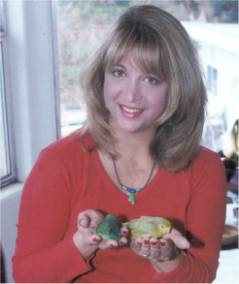Hi Sandy,
You may remember me. My name is Cailin Callahan and we have spoken on the phone a few times back when I was looking for breeder pairs of spectacled parrotlets. Presently I have two pairs -- only one of which has begun reproducing. This pair is unrelated and have produced 4 babies, presently fledging and appearing to be made up of 3 hens and a male. They are 4 weeks old having hatched all in the first week of December. I have another breeding pair which has yet to do anything. The male of this pair is the brother to the male of the reproducing pair and the hen of this pair is the sister of the hen of the reproducing pair. Offspiring from this couple will be double first cousins to the offspring of the first pair and so they would be a little too closely related to take the progeny of these two pairs and breed them.
I am writing to find out if you are still breeding spectacled parrotlets and if you know of an aviary called "three sisters" in North Carolina. I understand she was looking for specs to trade recently but I have been unable to find her. Also, I will soon be looking to sell these babies which have all been regularly handled and hand fed intermittantly. None of them bite but one does shout at you a bit at first when you handle him. They would all make great pets or breeder birds.
Thanks for any help you may be able to give and best of luck to you in 2012!
Cailin
Dear Cailin:
Thank you for your email. If you have read any of my materials you would know that Spectacles didn’t come into the US until 1992, right before the Wild Bird Conservation Act was passed. This prohibited the importation of all the species of parrotlets except for color mutation Pacifics. The birds that were imported in 1992 came from Europe so they were not wild caught birds and there were less than 20 pairs imported. This means that pretty much all of the birds around today are all related in some way – many of whom are very closely related. Just because you get birds from someone else, is no assurance that the birds are not related. I love to tell the story of a friend who bought WILD CAUGHT macaws – one from TX, one from FL and one from CA. He had them DNA’ed and ALL of them were related. And if that happened with wild caught birds, you can be assured that the original pairs that came in the country in 1992 were probably all related because they all came from one breeder in Belgium. The only reason the birds are still around today is because a) the International Parrotlet Society created a breeding cooperative and a managed studbook so that the original pairs’ offspring were as widely distributed as possible and b) the birds that came in were very healthy and were excellent founder stock. Unfortunately, each generation brings the inbreeding quotient higher and higher until eventually the birds will all be sterile or have incapacitating genetic abnormalities. There is no way to prevent this since the Federal government will not allow the importation of new stock. Very sad and as someone who was one of the first people in this country to breed Spectacles and is a co-founder of the International Parrotlet Society who worked for 2 decades to preserve these species, it is incredibly sad. But, people wanted to make money breeding color mutation Pacifics, as well as feeding their own ego’s to make pretty new colors, so the other species – Mexicans, Blue Wings, Yellow Face and even the more common ones such as Green Rumps and Spectacles are pretty much genetically, if not literally, extinct in this country. Another 10 years, and they will all be gone. Very sad.
3 Sisters Aviary used to be members of the International Parrotlet Society but no longer are so I have no idea if they are still around or not. All of my birds are in breeding cooperatives and are traded with zoos and biological parks. I do not sell them into the pet trade.
I wish I had better news for you but unfortunately, that is the state of birds these days. Best of luck to you in your endeavors and if you would like to get more detail, I have a blog as well as an article in the July/August 2011 IPS journal on genetically extinct species of parrotlets and how they came to be that way. It is sad but an interesting read and I am one of the few people in this country that can accurately report it since I was there.
Sincerely yours,
Sandee L. Molenda, C.A.S.
The Parrotlet Ranch, Owner, www.parrotletranch.com
Join the International Parrotlet Society, – the World’s Largest and Oldest Parrotlet Organization www.internationalparrotletsociety.org
A Chattering Bird Builds No Nest.
Camaroonian Phrase
Subscribe to:
Post Comments (Atom)




No comments:
Post a Comment
Note: Only a member of this blog may post a comment.